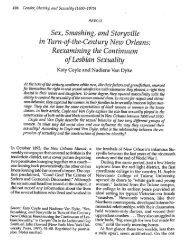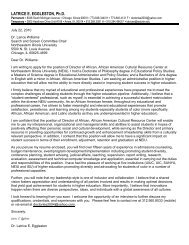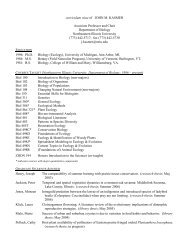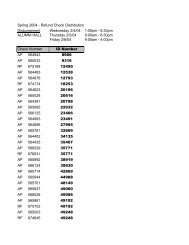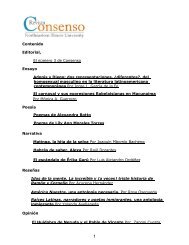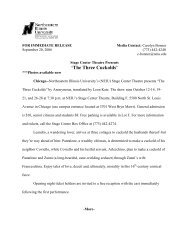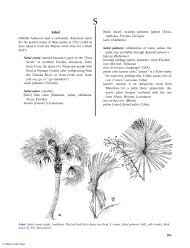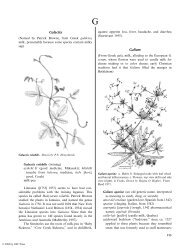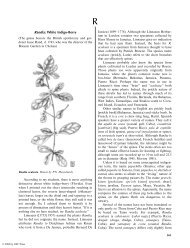Herba Cana - Northeastern Illinois University
Herba Cana - Northeastern Illinois University
Herba Cana - Northeastern Illinois University
Create successful ePaper yourself
Turn your PDF publications into a flip-book with our unique Google optimized e-Paper software.
© 2004 by CRC Press<br />
550 Florida Ethnobotany<br />
compound quinine, an alkaloid first isolated in<br />
1820 by French Pierre-Joseph Pelletier and<br />
Joseph-Bienaime Caventou; the word ‘‘quinine’’<br />
appeared in English by 1826, although it had<br />
been used in Spanish as quina or quinaquina,<br />
taken from Quechua, since at least the 1640s)<br />
sinaptahaspí (sinapó, ash, tahaspí, light [weight],<br />
Koasati)<br />
skunk-bush [skunkbush] (the odor caused comparison<br />
with the skunk, whose name was taken from<br />
the indigenous Abenaki seganku or segongw, the<br />
weasel relative Mephitis mephitis)<br />
stinking-ash; wafer ash (‘‘wafer’’ refers to the flat,<br />
rounded fruits, like the thin, crispy cake that<br />
gave rise to the Old English wafre, and our word<br />
‘‘waffle’’; the word ‘‘ash’’ compares it with<br />
Fraxinus because of the leaves)<br />
swamp dogwood (a misnomer or misidentification;<br />
this is an upland plant)<br />
[shrubby, tree] trefoil (called ‘‘trefoil’’ from Latin<br />
trifolio, three leaves because of the compound,<br />
trifoliolate leaves)<br />
wahoo (from uhawhu, a Creek word for the elm;<br />
however, the Dakota wahú, arrowwood, was<br />
applied to Euonymus)<br />
wing-seed<br />
The first living hop-trees to arrive in Europe were<br />
those sent to England by Reverend John Banister in<br />
1704 (Millspaugh 1893). Those plants died, but Mark<br />
Catesby reintroduced the shrubs about 1724. Subsequently,<br />
hop-tree was cultivated in other places in<br />
Europe.<br />
Both Leonard Plukenet in 1696 and Johann Jakob<br />
Dillenius in 1732 had studied specimens of these<br />
plants and called them Frutex virginianus trifolius,<br />
ulmi samaris (three-leaflet shrub from Virginia, with<br />
samara fruits like the elm). When Linnaeus examined<br />
the shrubs, he realized they were distinct from the elm,<br />
which he called Ulmus (which see). Linnaeus began<br />
calling the New World plants Ptelea in his Hortus<br />
Cliffortianus of 1738 and continued using the name in<br />
Species Plantarum ([1753] 1957).<br />
Although Linnaeus knew Ptelea only from Virginia,<br />
William Bartram ([1791] 1958) recorded the<br />
shrubs in North and South Carolina, Alabama,<br />
Georgia, and northern Florida between 1773 and<br />
1777. André Michaux, during his visit to Florida in<br />
1788, found the plants in Alachua, Levy, Orange, and<br />
Putnam Counties (Taylor and Norman 2002). There<br />
are now about 11 species recognized in this North<br />
American endemic genus (Bailey 1962, Mabberley<br />
1997). Numerous varieties of P. trifoliata have been<br />
named, and these intergrade in a confusing manner.<br />
Perhaps the first record of medicinal use of the<br />
wafer-ash in the Americas was by the German<br />
physician Johann David Schoepf (1752 /1800) who<br />
visited during the Revolutionary War in 1783 /1784.<br />
He and others of the period considered it aromatic,<br />
bitter, stimulant, and an expectorant tonic useful<br />
against malaria (Millspaugh 1893). They surely<br />
learned about the plant directly or indirectly from<br />
indigenous people, but that does not seem to have<br />
been recorded.<br />
Later, Rafinesque reported Ptelea in his Medical<br />
Botany of 1830. As usual, he obtained much of his<br />
information from indigenous people, but typically<br />
declined recording who and where. Rafinesque considered<br />
the plants vulnerary and vermifuge (Millspaugh<br />
1893). Based on his report, the plants were<br />
most likely used by tribes where he explored; however,<br />
actual reports have been found for only two groups not<br />
visited by Rafinesque. The Menominis considered the<br />
root bark of P. trifoliata, a plant brought to Wisconsin<br />
from Kansas, as a sacred medicine and panacea to<br />
season and render other medicines potent (Vogel<br />
1970). The Meskwakis used it similarly, and for lung<br />
problems, often in tea with other barks (Vogel 1970).<br />
Those reports are also the only ones found by Lewis<br />
and Elvin-Lewis (1977) and Moerman (1998) regarding<br />
indigenous people in the United States. However,<br />
in Mexico the plants are still used in remedies for<br />
dyspepsia, as a mild tonic, in a bath of an alcoholic<br />
infusion of leaves against chills, and to treat rheumatism<br />
(Martínez 1969).<br />
Following Rafinesque, several American physicians<br />
promoted wafer-ash as a medicine. Eclectic<br />
physicians considered it second only to hydrastis<br />
(Hydrastis canadensis) as a tonic, and they thought<br />
a cold infusion of the plants especially good for<br />
debilitating fevers (Culbreth 1910, Felter 1922).<br />
Martínez (1969) reported that the bark of the root<br />
contains the alkaloid berberine, but that has not been<br />
confirmed in more recent chemical studies. It does<br />
contain a variety of alkaloids, including dictamnine,<br />
pteleine, ptelecultinium, pteleatinium chloride, and<br />
several others. In addition to the alkaloids, the plants<br />
produce coumarins (Bailey et al. 1971, Szendrei et al.<br />
1973, Mitscher et al. 1975a,b, Petit-Paly et al. 1987,<br />
1989). At least the pteleatinium chloride is antibacterial,<br />
and some of the other compounds are antipyretic,<br />
antifungal (antiyeast), and effective against the tuberculum<br />
bacillus (Hocking 1997, Mabberley 1997).<br />
Decoctions from roots have been used as a stomach<br />
tonic and for oral and throat diseases (inflamed<br />
uvula). The leaves and shoots still are considered<br />
anthelmintic (Hocking 1997, Vásquez and Jácome<br />
1997). Equal parts of fresh leaves and bark are used<br />
by German homeopathics (Hocking 1997). According





